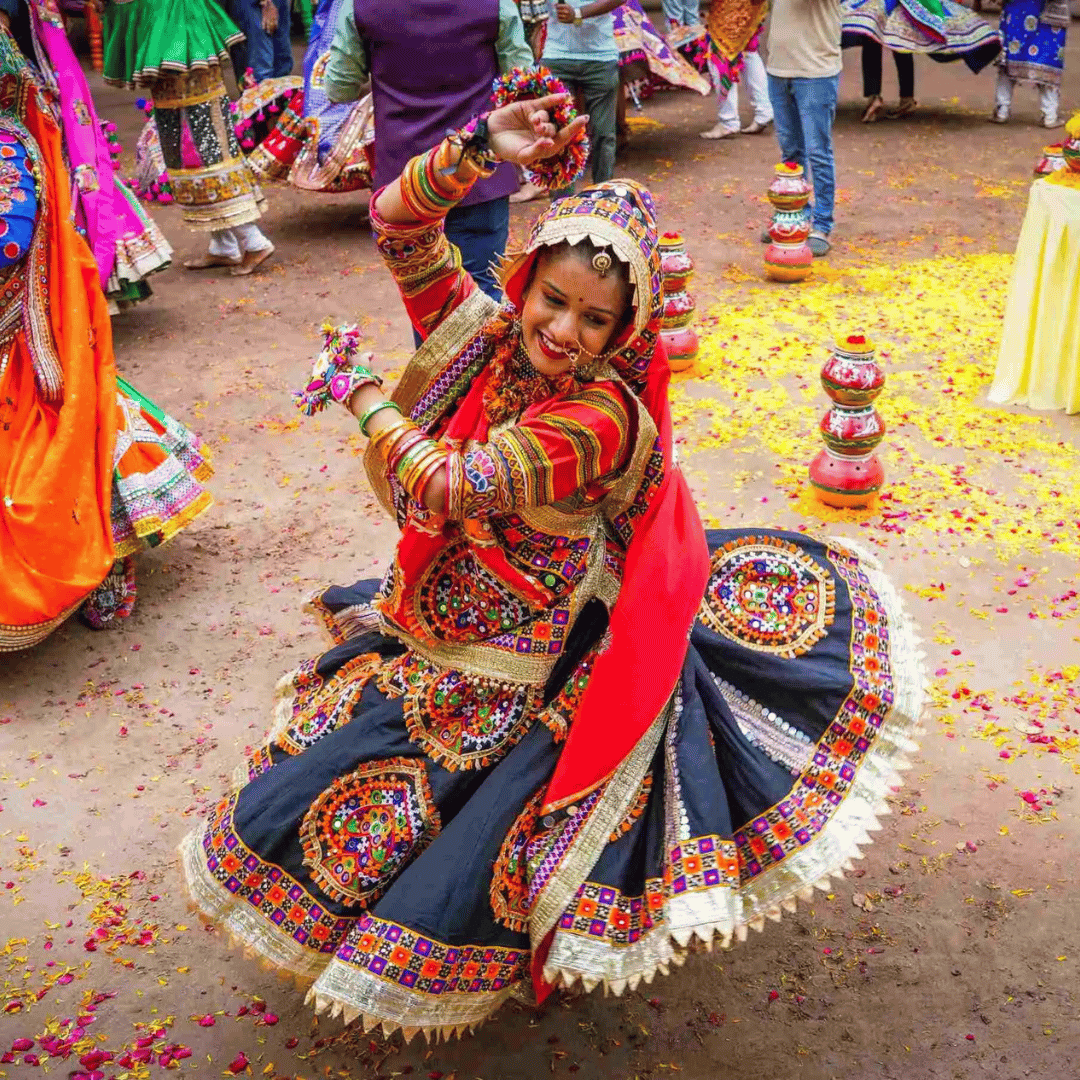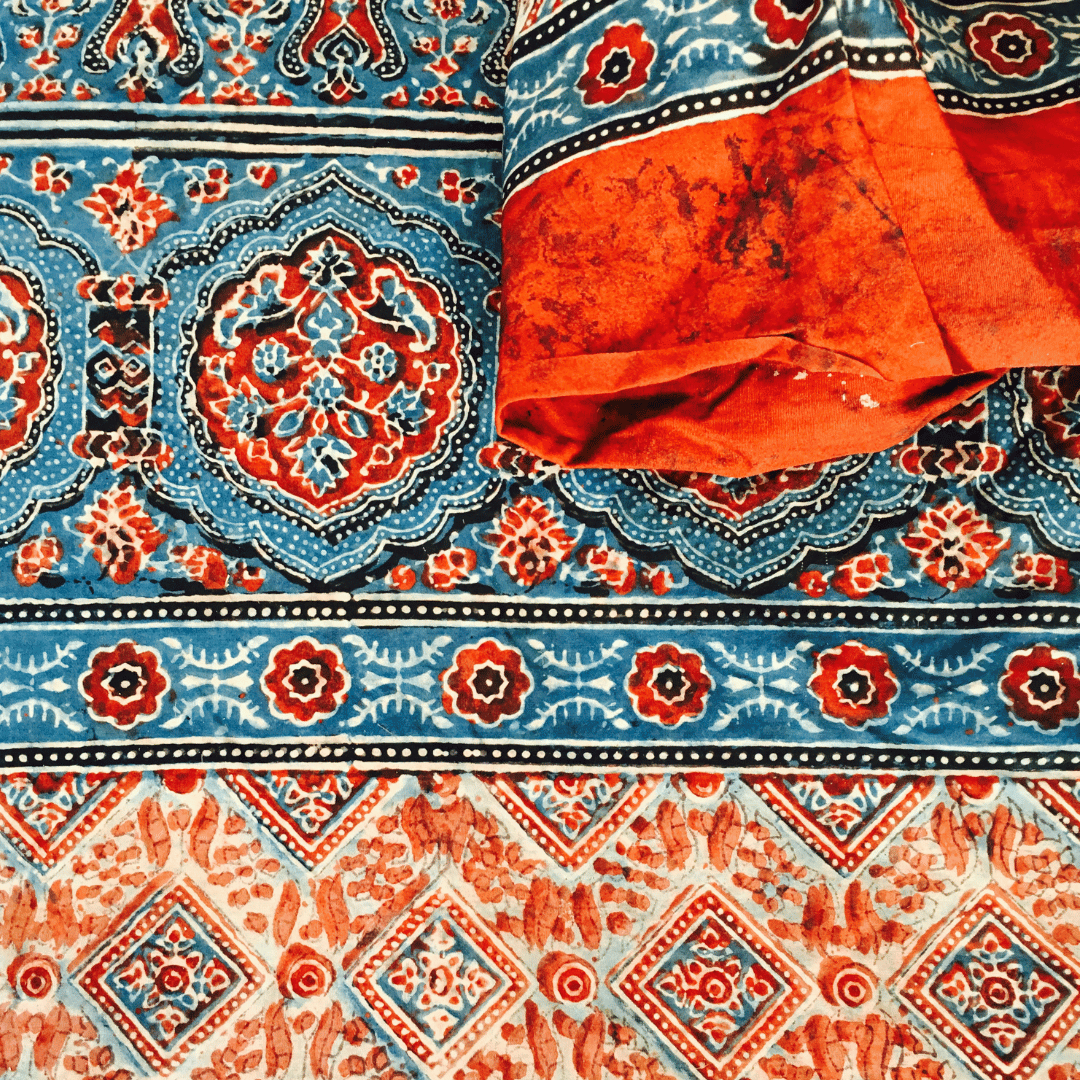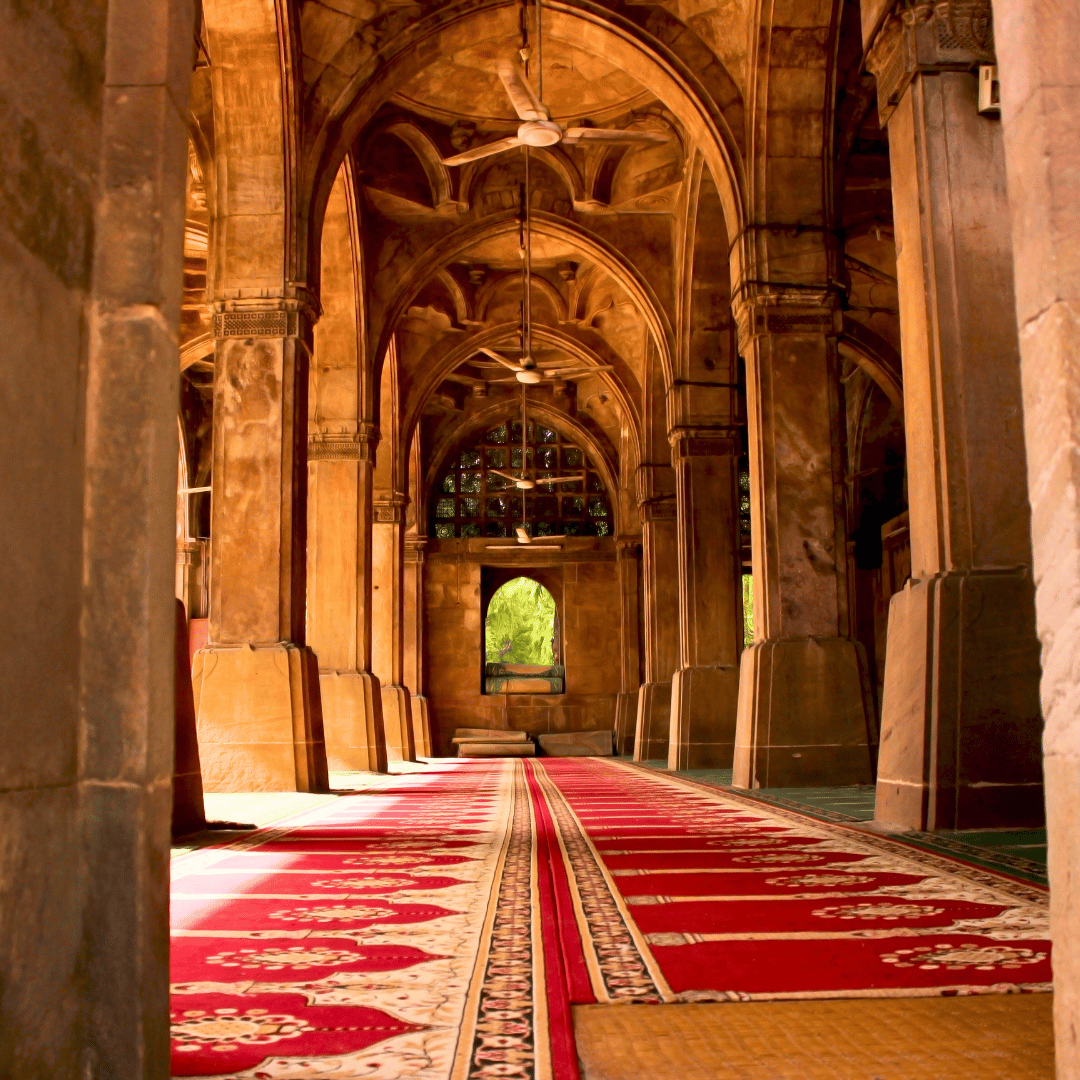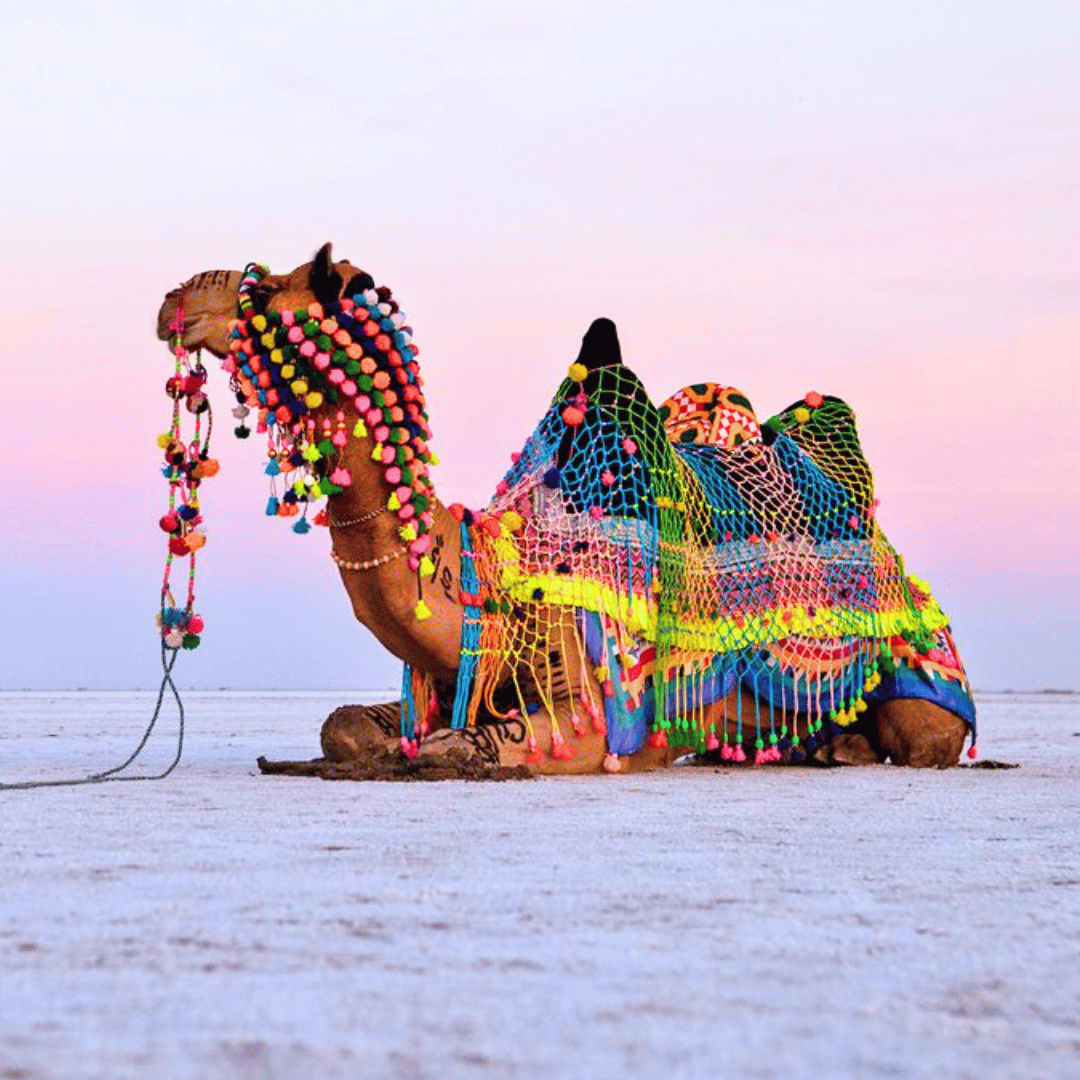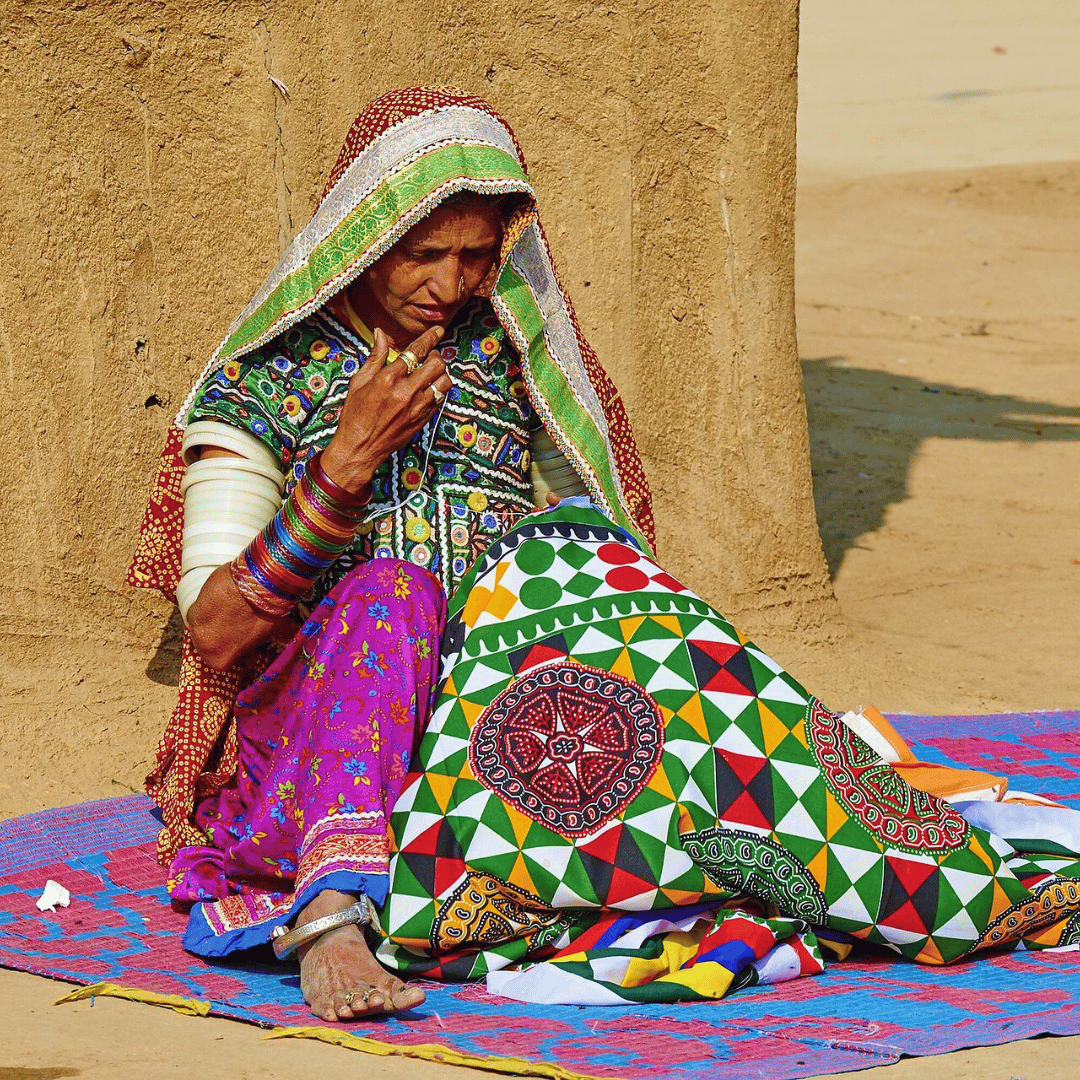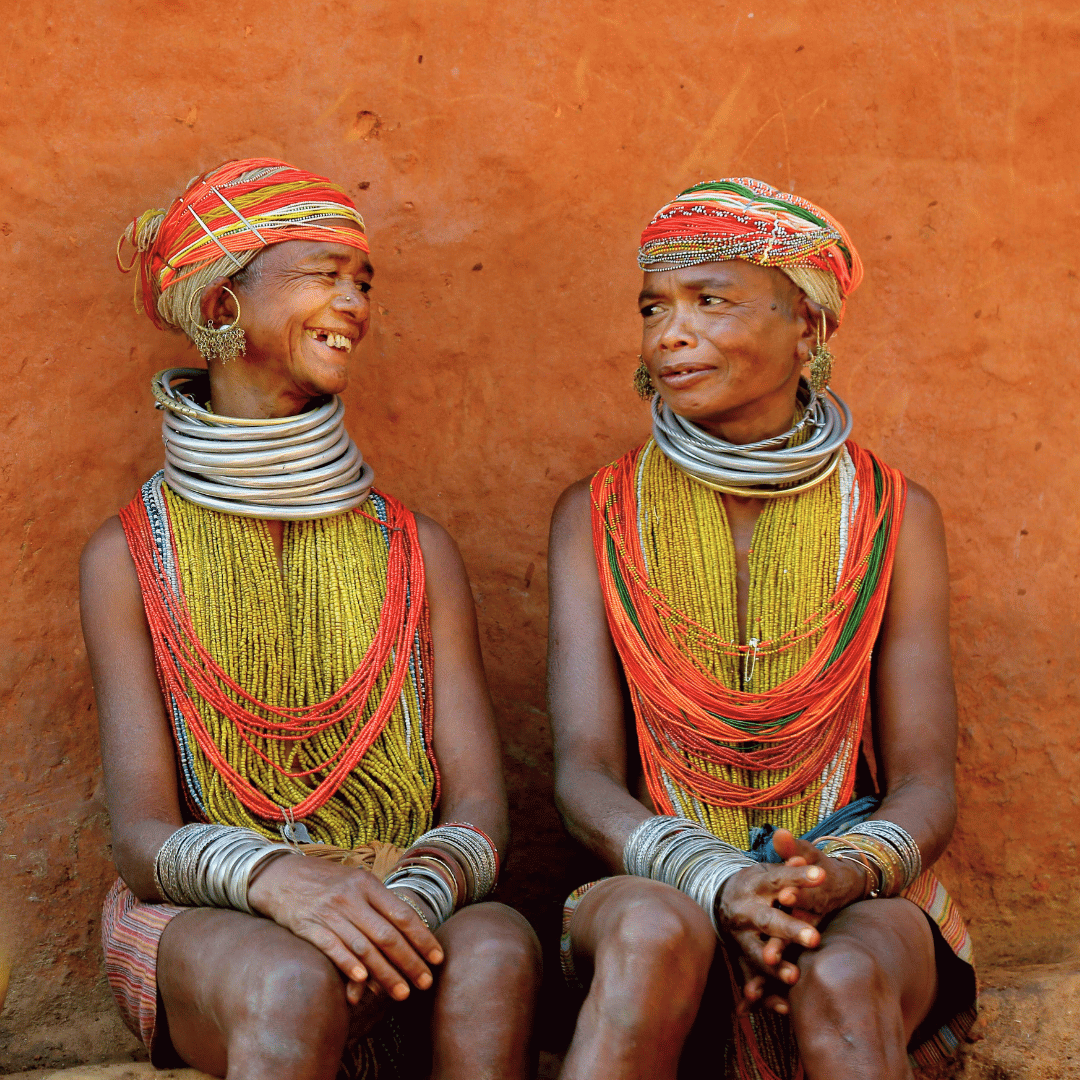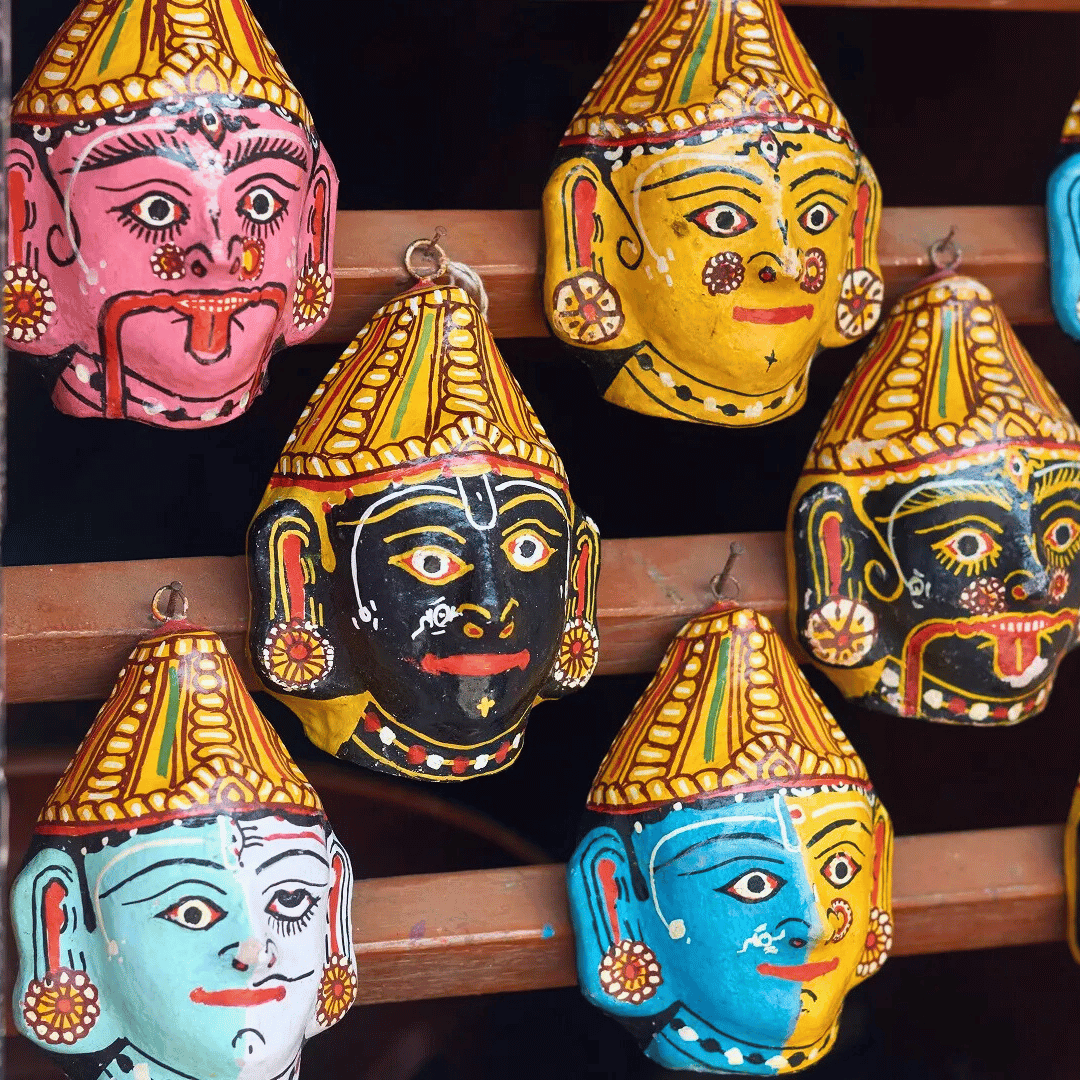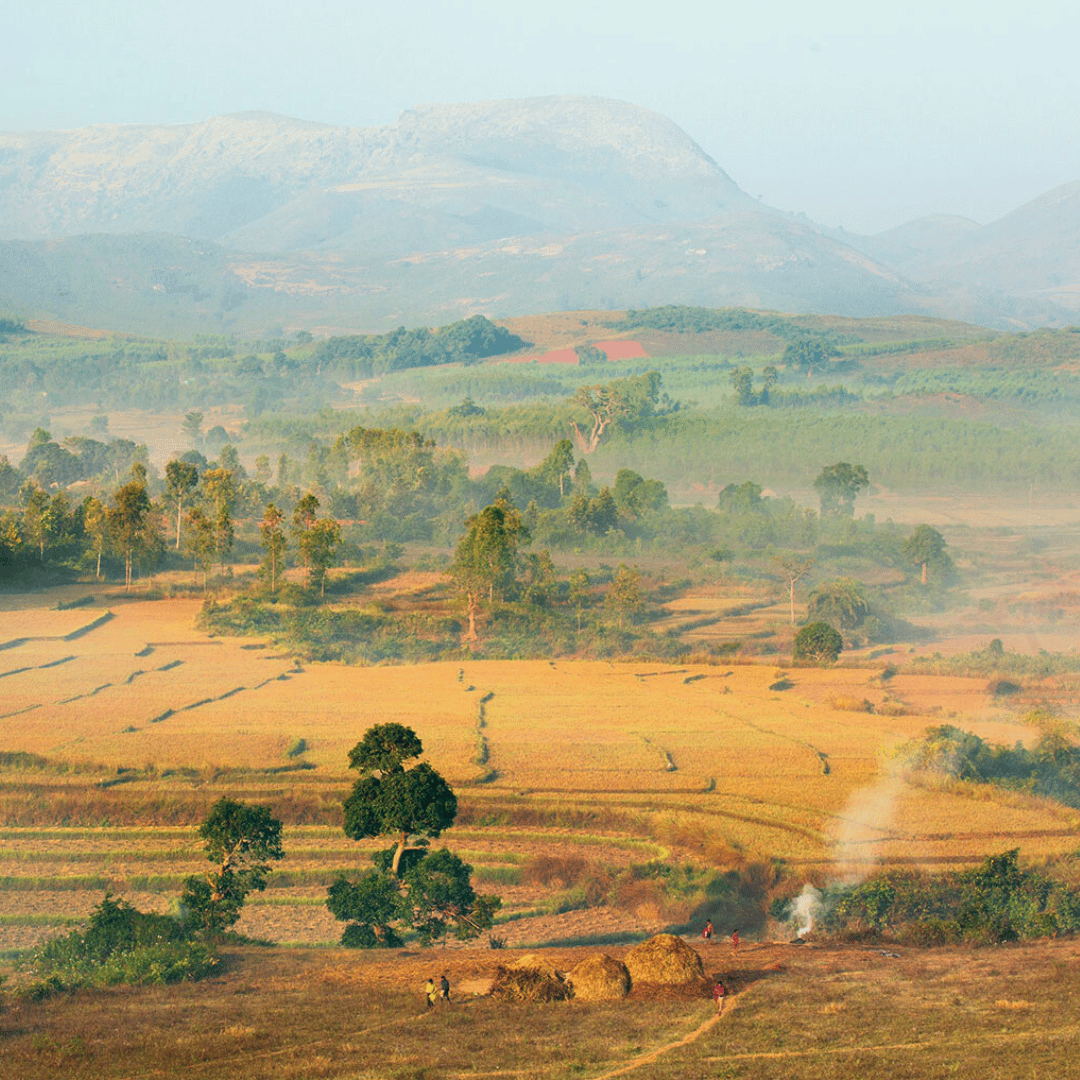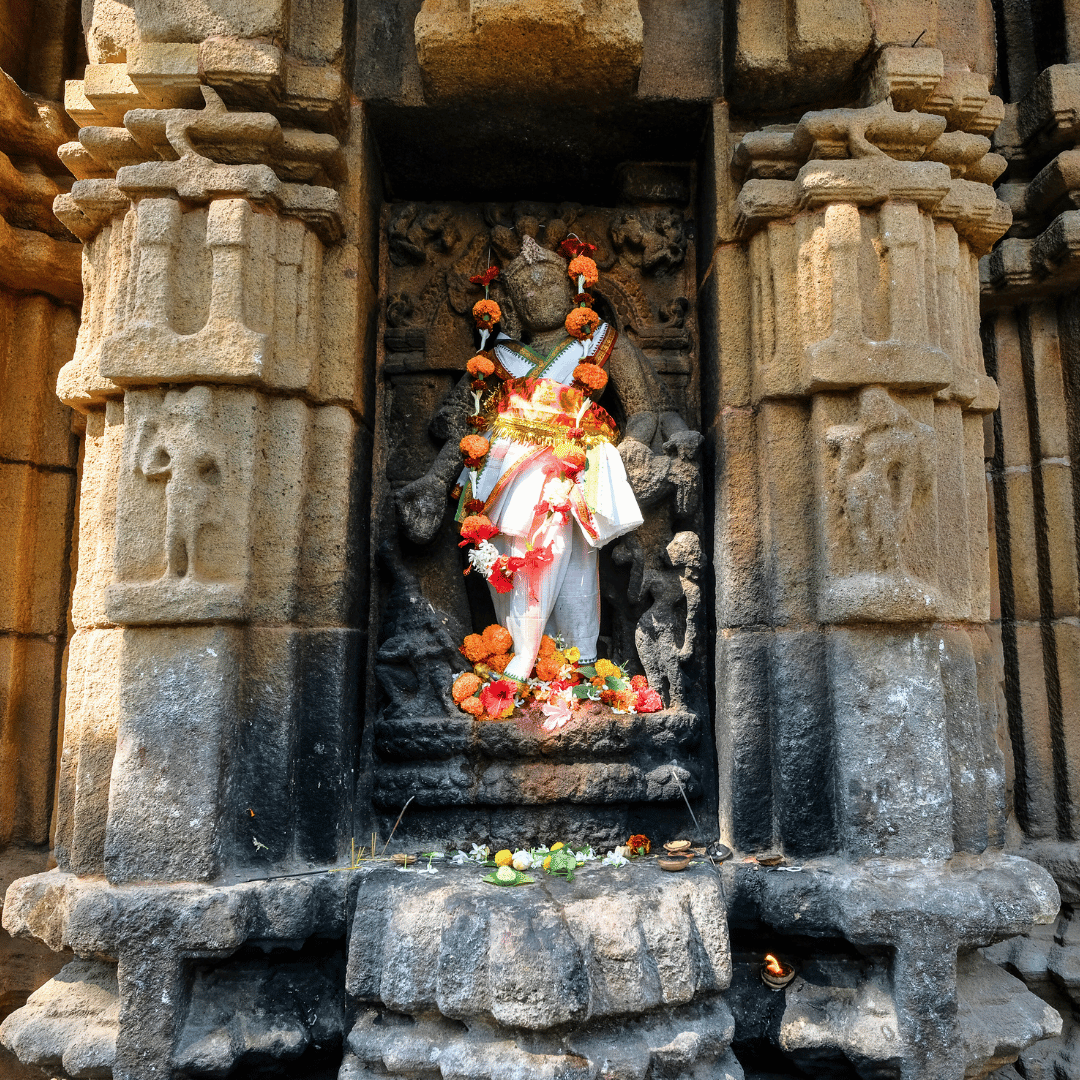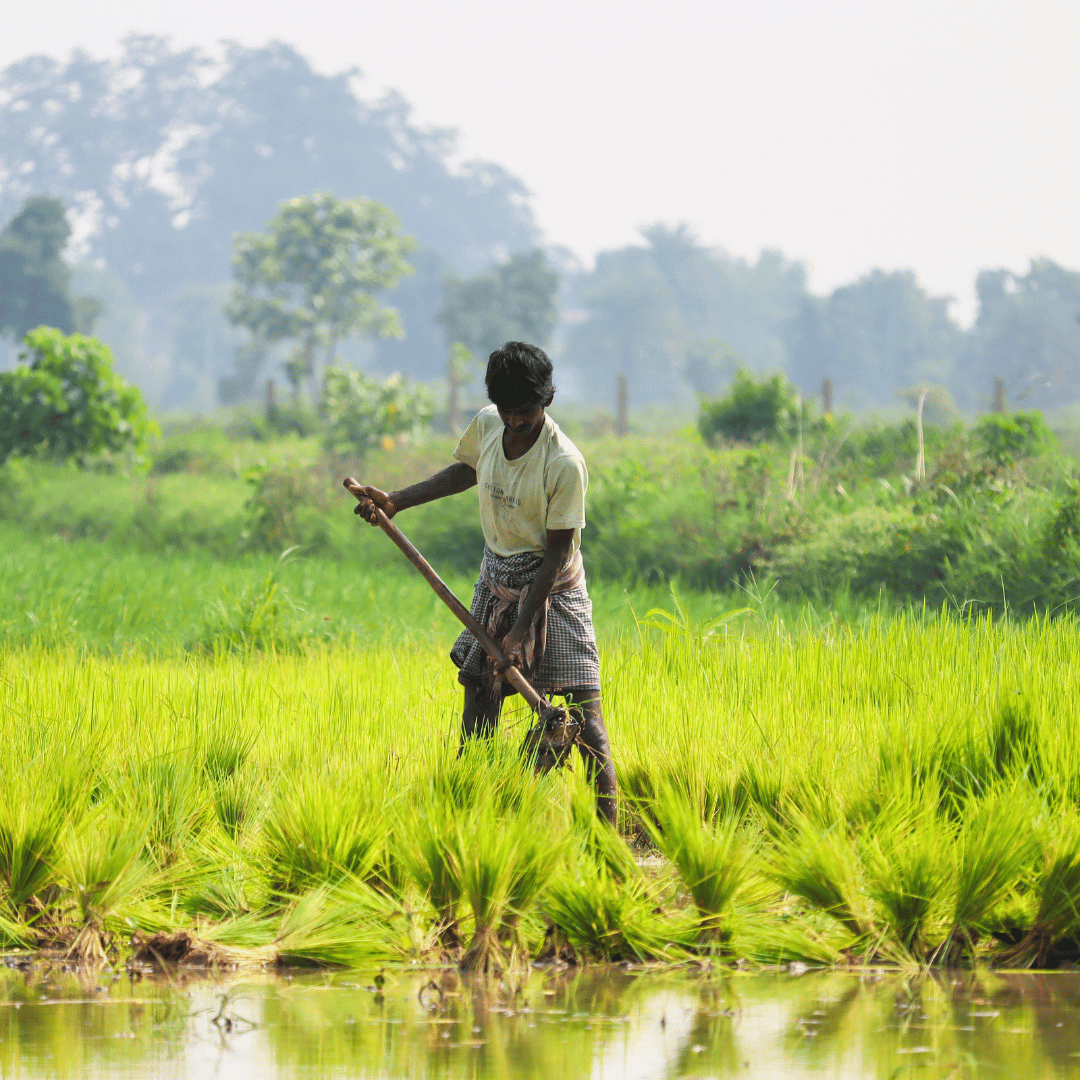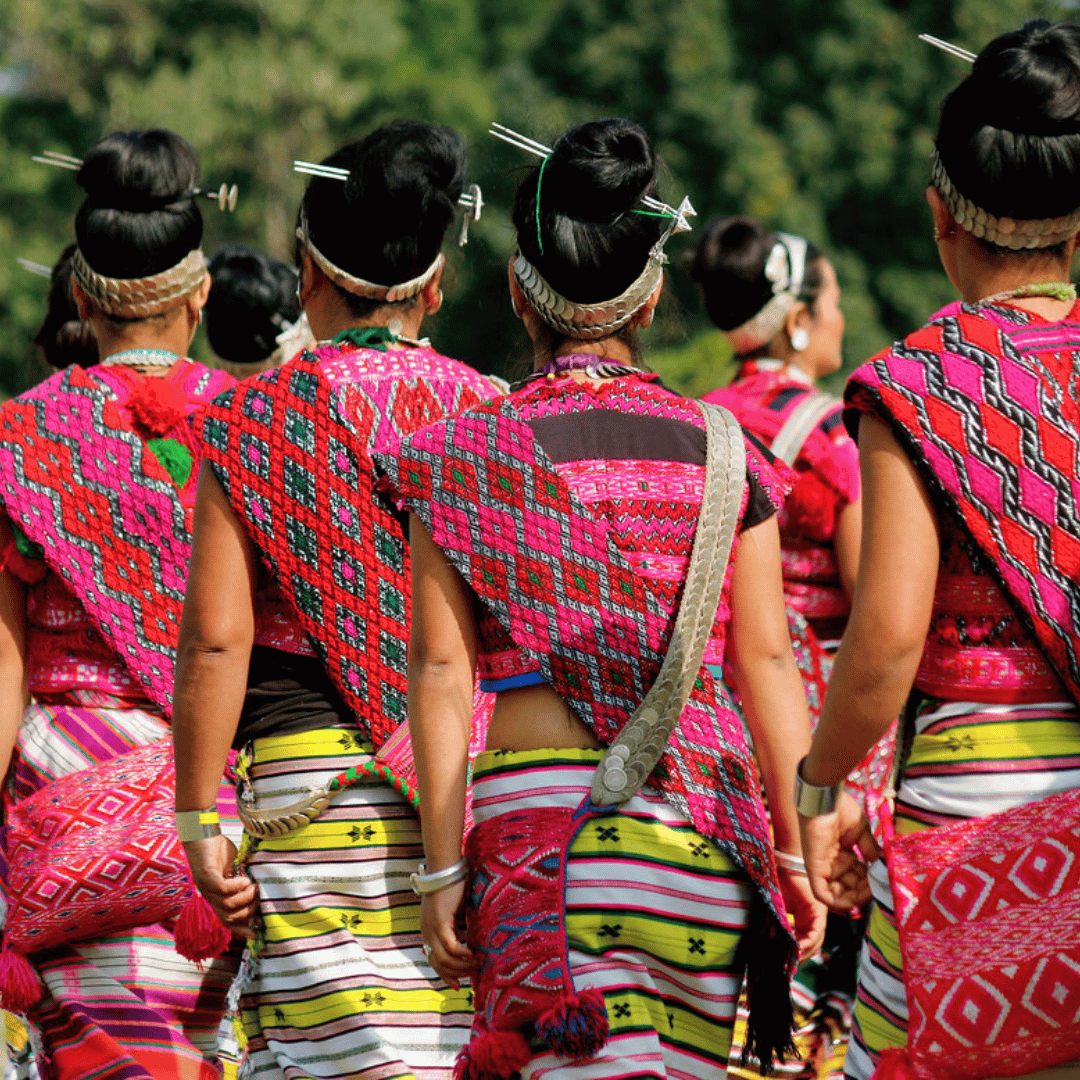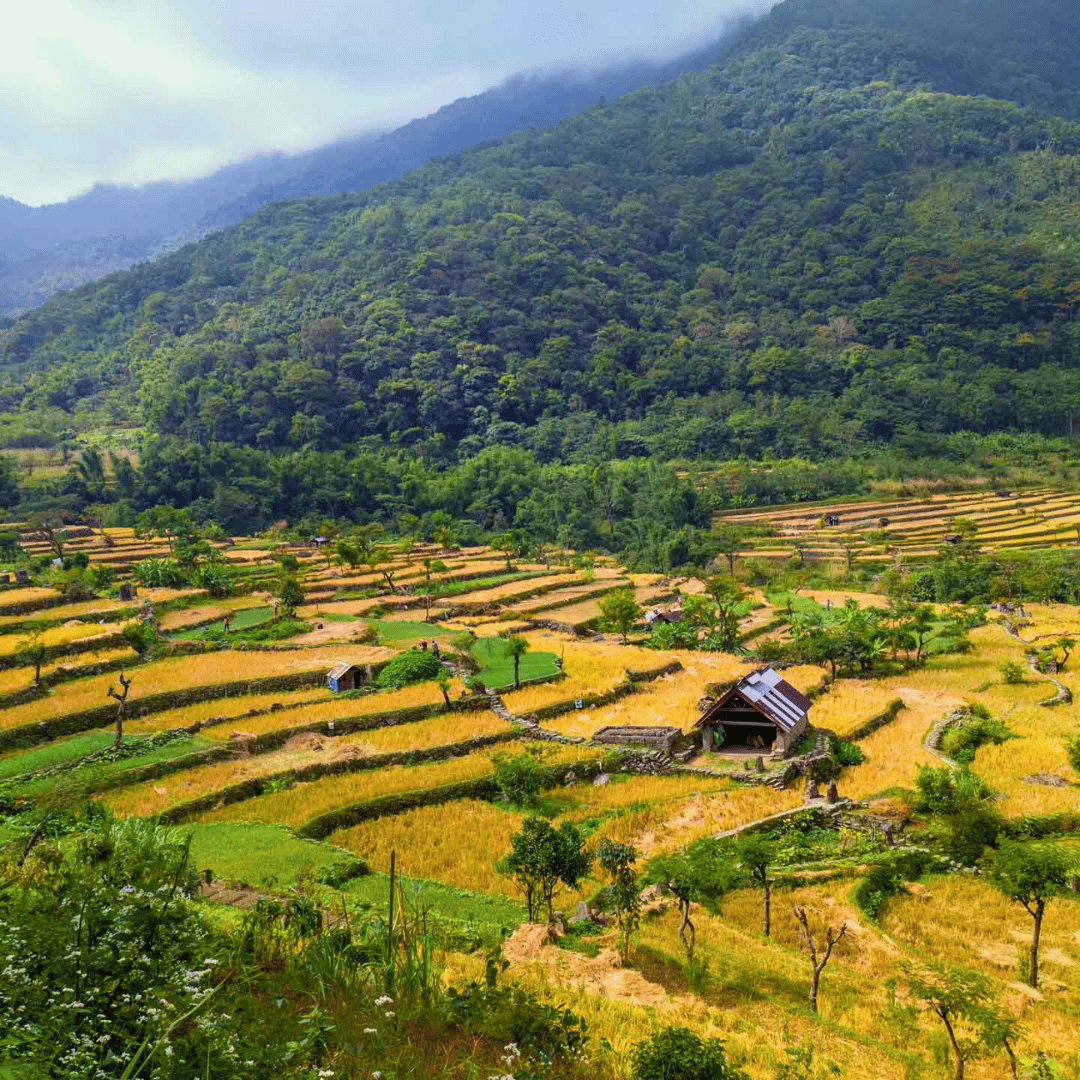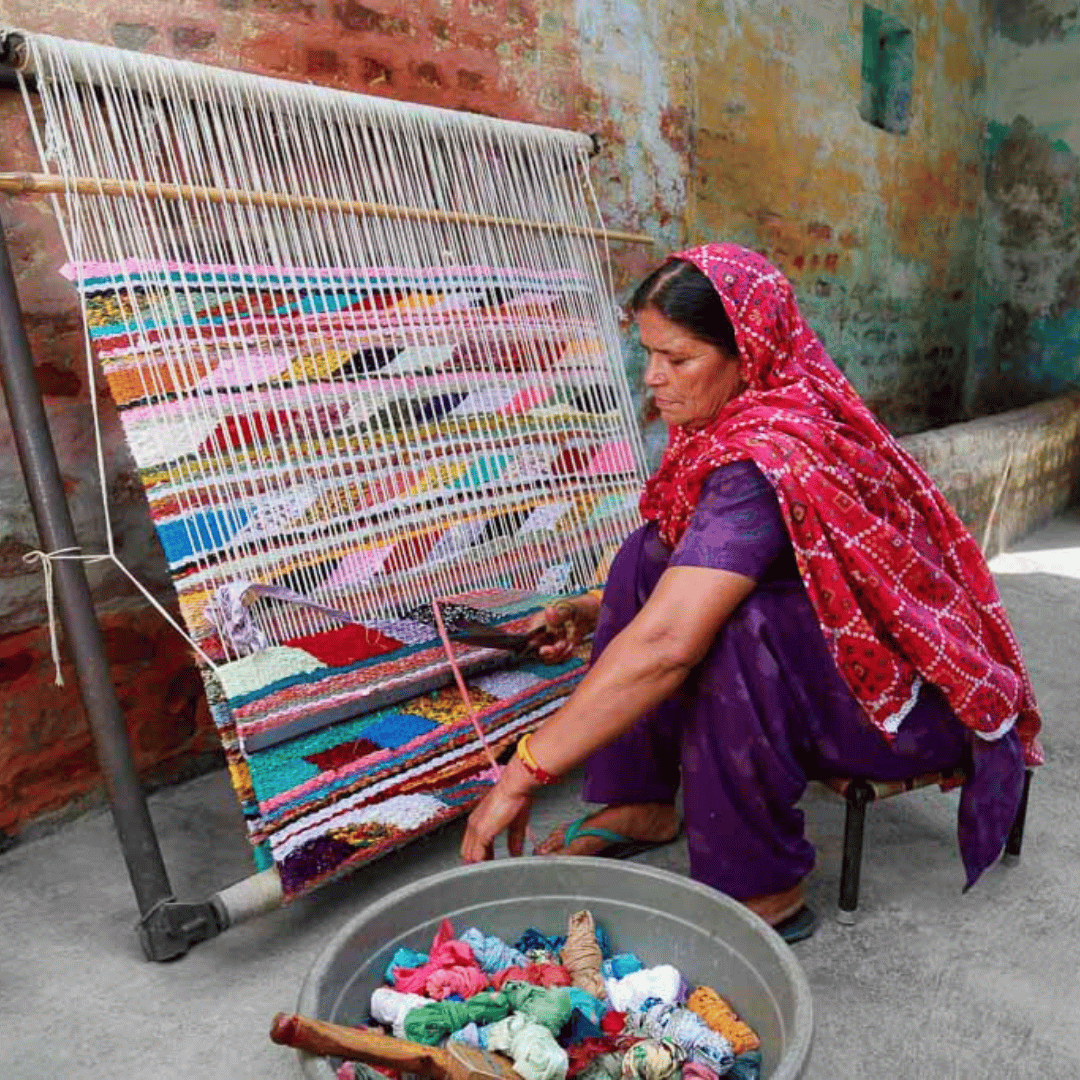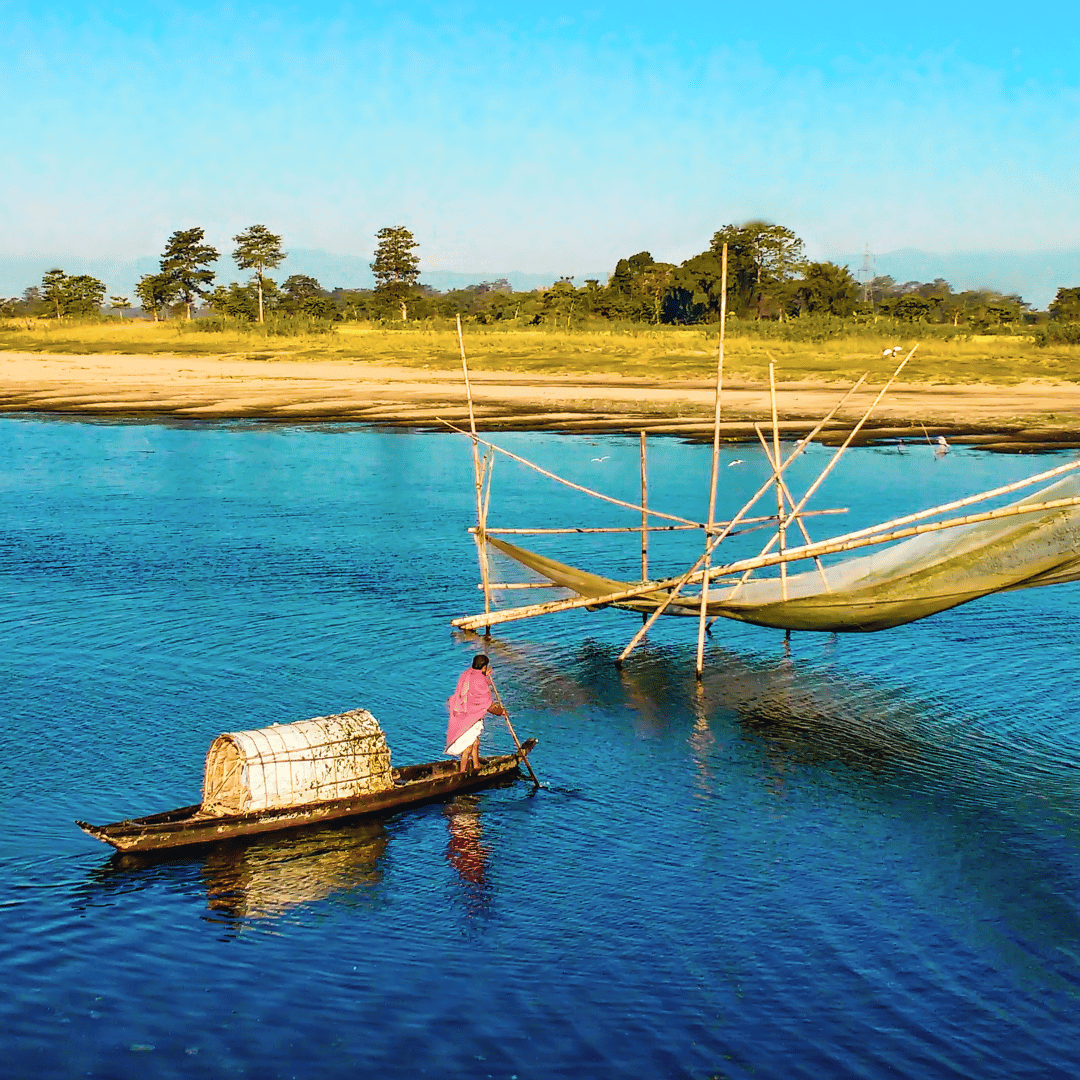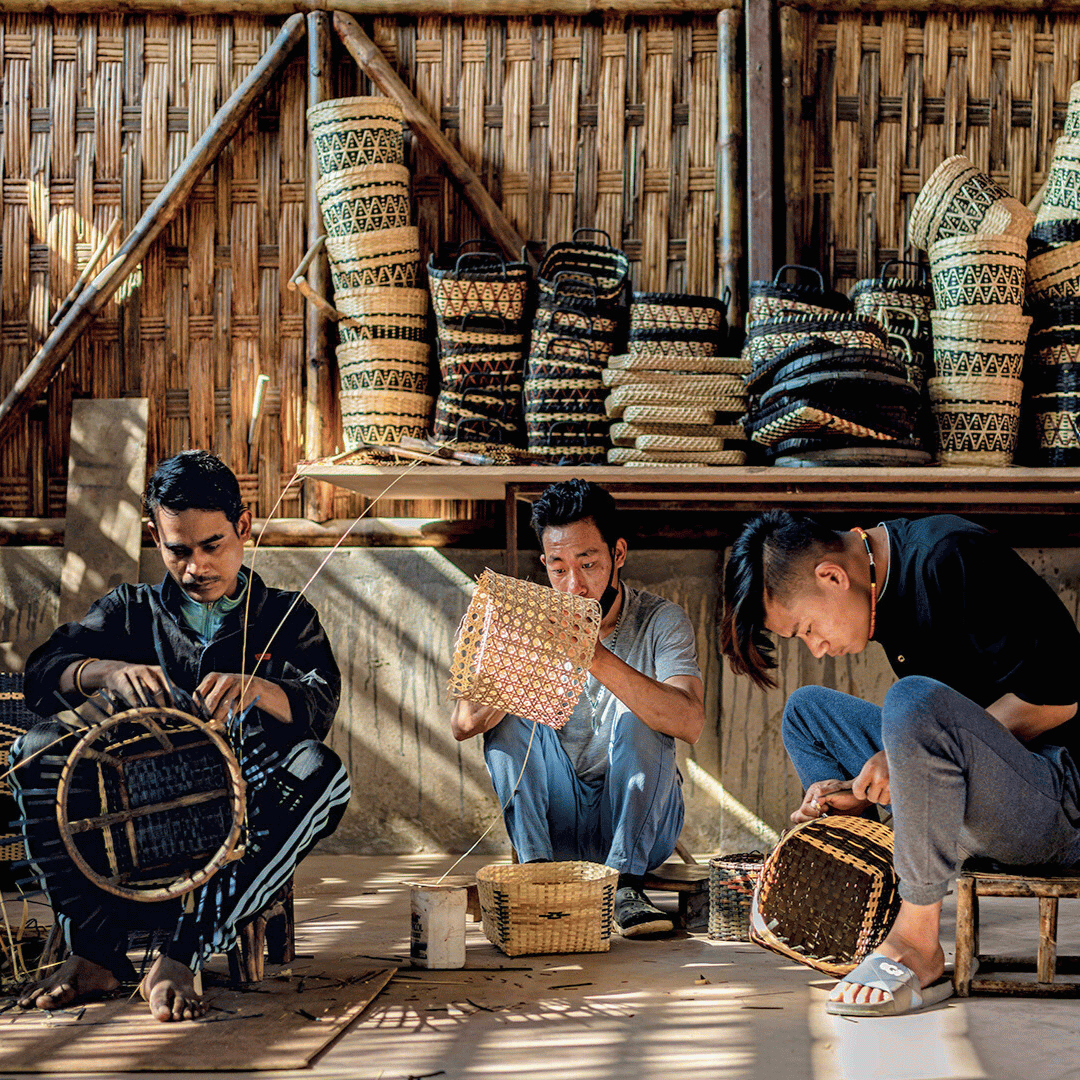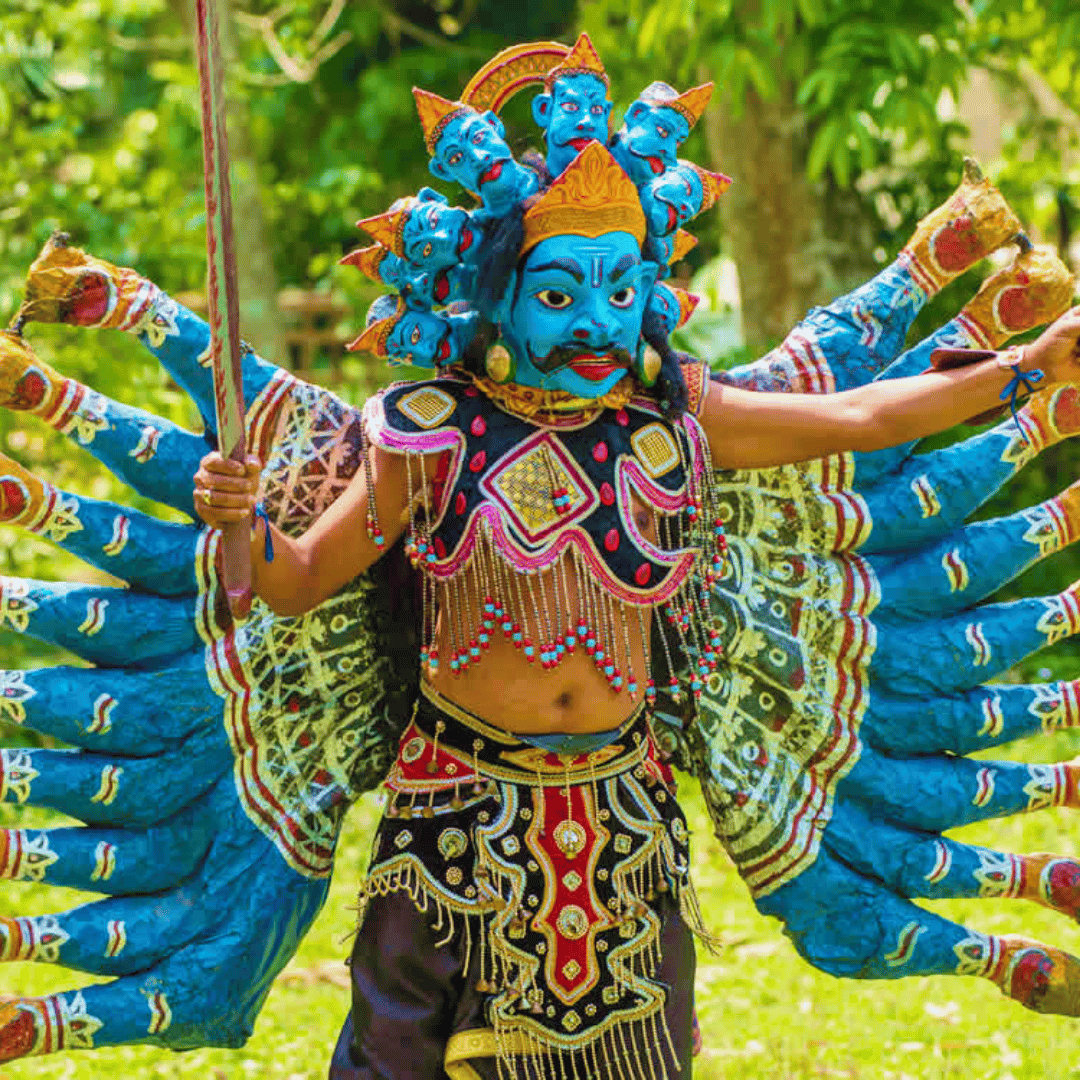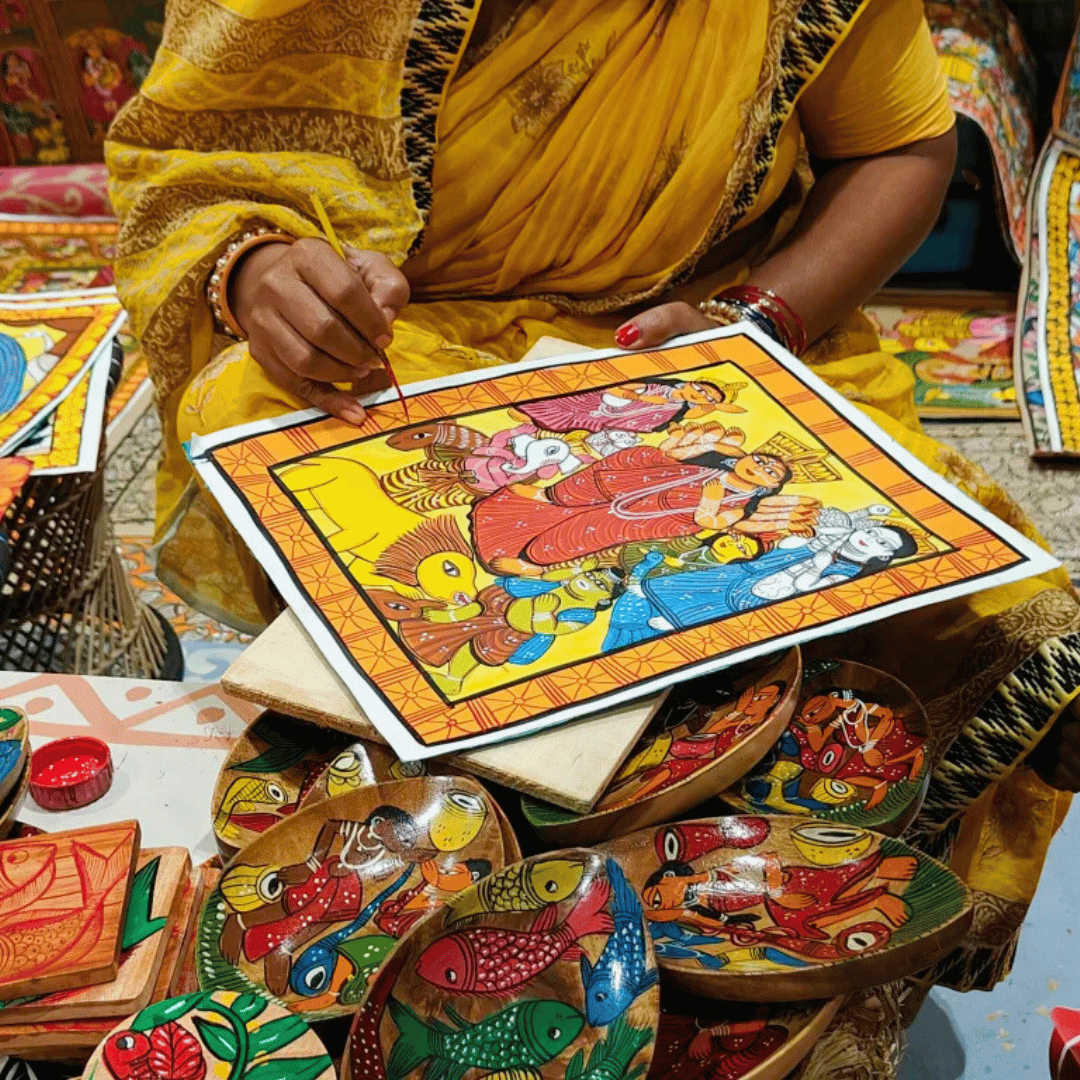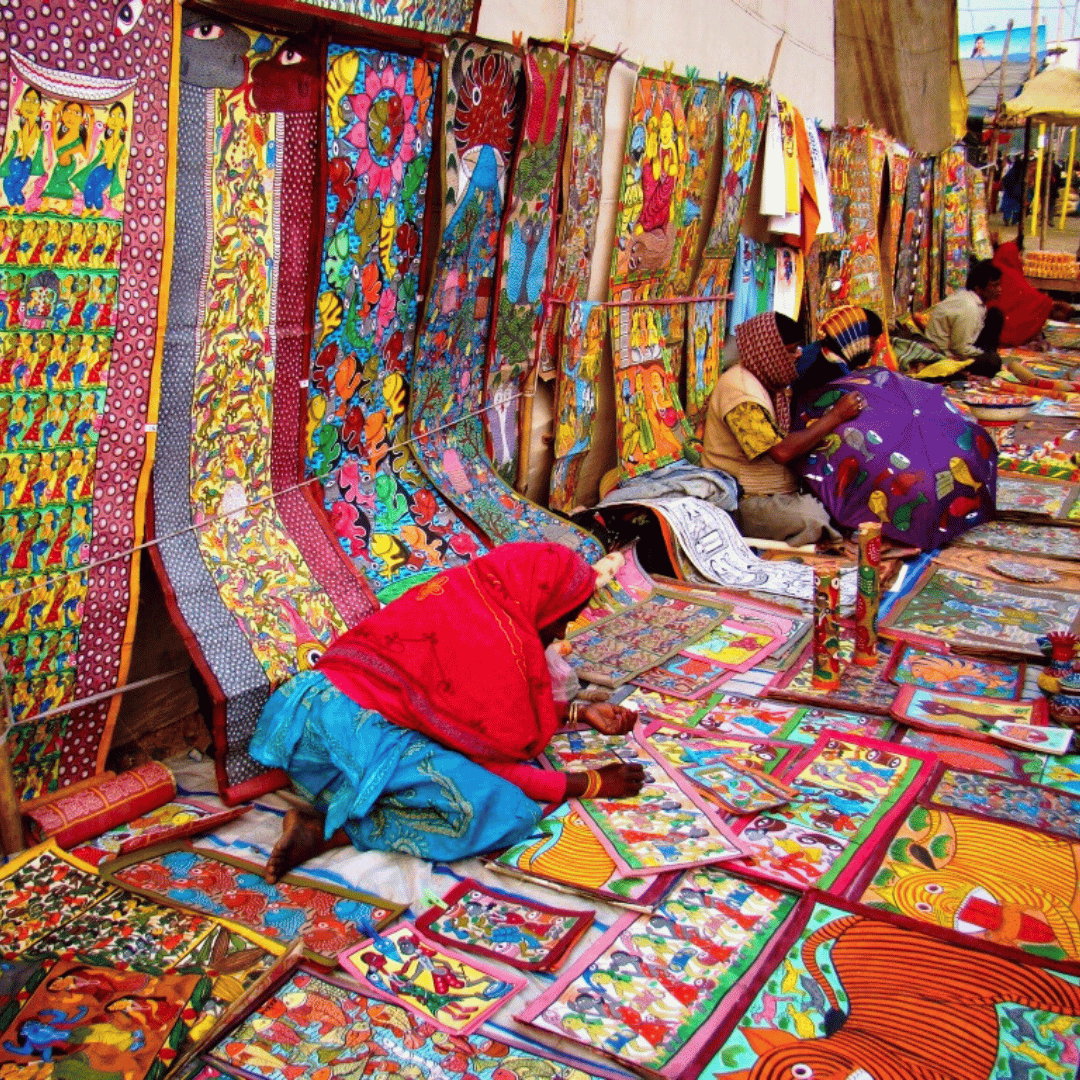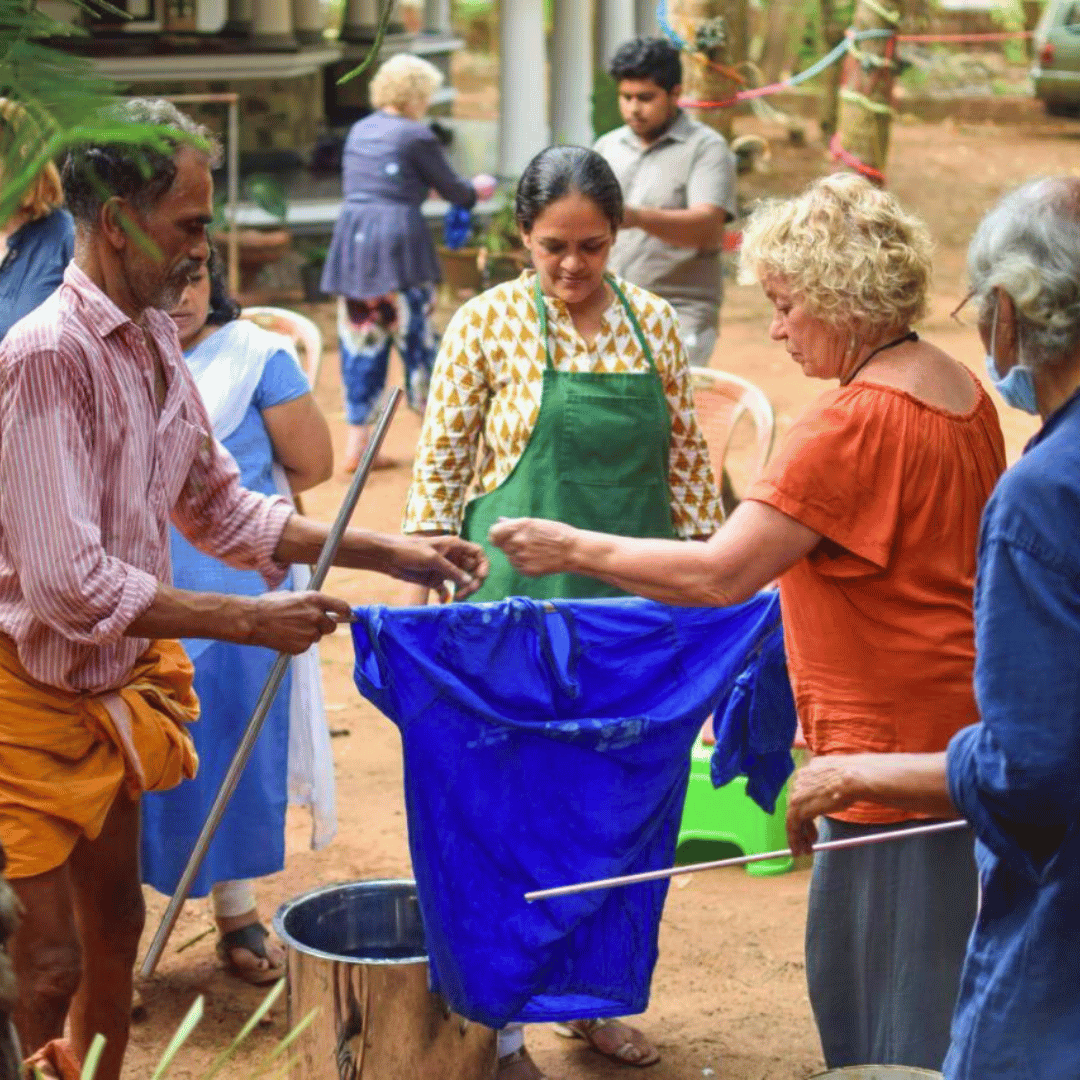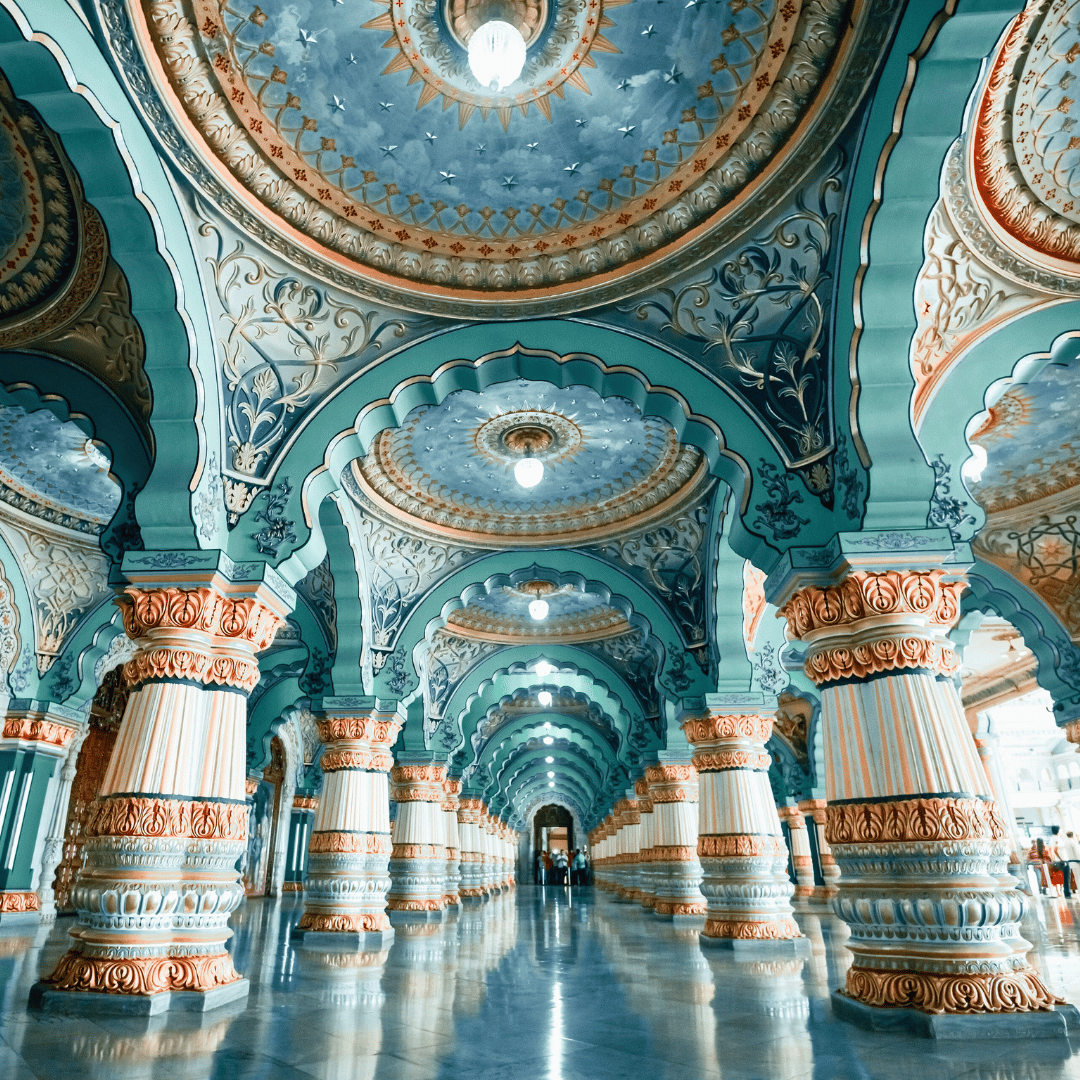Gujarat Textile Tour Itinerary
-
Welcome to Gujarat! Situated on the banks of the Sabarmati River, Ahmedabad was founded in 1411 by Sultan Ahmad Shah, who transformed the city into a thriving hub for trade and craftsmanship. Attracting skilled artisans and merchants, Ahmedabad soon became a centre of textile production, a legacy that continues to define the city today. Now the largest city in Gujarat, with a population of around six million, Ahmedabad remains a significant centre for both traditional and contemporary textiles. Artisans here specialise in various crafts, including Mata-ni-pachedi, a unique form of narrative cloth painting, as well as hand-block printing, which has been practised for generations.
On arrival, you will be met and transferred to the House of MG, a beautifully preserved heritage hotel that offers a glimpse into Ahmedabad’s textile legacy. Originally built in 1924 as the residence of Mangaldas Girdhardas, a prominent textile magnate, the mansion reflects the grandeur of Ahmedabad’s merchant elite. The ornate façade draws from Baroque influences, while the Italian mosaic marble flooring, stained glass windows, and interconnected courtyards create an atmosphere of timeless elegance. As a family-owned property, the House of MG blends historical charm with modern comforts, making it an ideal place to experience Ahmedabad’s rich architectural and textile heritage.
-
This morning, visit the Calico Museum of Textiles, one of the most prestigious textile museums in the world and a cornerstone of India’s rich textile heritage. Established in 1949, the museum houses an outstanding collection of Indian fabrics, showcasing handcrafted textiles that span over five centuries. The exhibits range from intricately woven silk and cotton fabrics to rare embroidered textiles, ceremonial cloths, and religious tapestries, each reflecting the depth of India’s textile traditions. The museum not only serves as an essential research hub for scholars from India and abroad but also plays a significant role in preserving and supporting India’s living textile traditions. It is a major reference point for traditional artisans and contemporary textile industries, ensuring that historic weaving and printing techniques continue to inspire future generations.
In the afternoon, you have the option to visit Sabarmati Ashram, the Shreyas Folk Museum, and the Gujarat Vidyapith Tribal Research and Training Institute, each offering a unique insight into Gujarat’s history, culture, and craftsmanship.
Sabarmati Ashram, located on a peaceful stretch of the Sabarmati River, was established by Mahatma Gandhi in 1915 as a retreat and later became the nerve centre of India’s freedom movement. It was from here that Gandhi launched the Dandi Salt March in 1930, a pivotal event in India’s struggle for independence. Today, the ashram functions as a memorial and research centre, with a library containing historical documents, photographs, and letters, providing a deep insight into Gandhi’s philosophy and the era of Indian nationalism.
For those interested in Gujarat’s diverse folk traditions, the Shreyas Folk Museum offers a remarkable collection of traditional arts and crafts from rural communities. The museum displays vibrant embroidered textiles, intricate wood carvings, metalwork, beadwork, leather craftsmanship, traditional costumes, and paintings, each piece showcasing the artistic heritage of different regions of Gujarat. The exhibits provide a comprehensive look at the state’s rural creativity and its deeply rooted artistic expressions.
Another fascinating stop is the Gujarat Vidyapith Tribal Research and Training Institute, which conducts studies on the life, culture, and economy of Gujarat’s tribal communities. The museum houses an extensive collection of tribal artefacts, including ornaments, musical instruments, traditional dress, and everyday household objects, offering a glimpse into the rich cultural practices of indigenous groups. The institute also preserves a valuable archive of photographs, slides, and films, documenting tribal traditions and customs, making it an essential centre for the study of Gujarat’s diverse tribal heritage.
-
After breakfast, set off on the drive to Dasada (approximately 3.5 to 4 hours by car), with stops along the way to explore some of Gujarat’s most remarkable historical and cultural sites.
Your first stop is Modhera, home to the 11th-century Sun Temple, one of the finest examples of Hindu temple architecture in western India. Built during the reign of the Solanki dynasty, the temple is dedicated to Surya, the Sun God, and is designed so that the first rays of the morning sun illuminate the sanctum. The temple complex features intricately carved pillars, detailed friezes depicting mythological scenes, and a large stepped water tank known as the Surya Kund, which adds to its architectural splendour. Walking through the temple’s sandstone corridors offers a glimpse into Gujarat’s rich artistic and religious traditions.
From Modhera, continue the drive to Patan (approximately 1 hour), a historic town known for its Jain temples, beautifully carved wooden houses, and the spectacular Rani ki Vav stepwell, a UNESCO World Heritage site. Built in the 11th century by Queen Udayamati in memory of her husband, this stepwell is one of India’s most exquisite, featuring intricately sculpted pillars, multiple levels of galleries, and more than 500 elaborate carvings of Hindu deities, celestial beings, and mythological scenes. The structure was designed not only as a water reservoir but also as a spiritual space, showcasing Gujarat’s remarkable architectural heritage.
Patan is also renowned for its patola silk weaving, one of the most complex and luxurious textile traditions in the world. The town is home to the Salvi family, master weavers who have preserved the double-ikat weaving technique, a process where both the warp and weft threads are dyed before being woven into highly intricate patterns. This painstaking method requires months of meticulous craftsmanship and results in vibrant, symmetrical designs that remain identical on both sides of the fabric. Visit a Salvi workshop to witness firsthand how these extraordinary textiles are created and gain insight into why patola saris have been prized by royalty and aristocrats for centuries.
After exploring Patan, resume the final leg of the journey to Dasada (approximately 1.5 hours), arriving by late afternoon. Settle into your accommodation and enjoy the evening at leisure, preparing for your upcoming adventure to the Little Rann of Kutch.
-
Set off early in the morning for a wildlife safari in the Little Rann of Kutch, a vast and unique landscape that, despite its stark and seemingly barren appearance, is rich in biodiversity. This expansive salt marsh is one of India’s most ecologically significant regions, home to a fascinating variety of wildlife, particularly local and migratory water birds that thrive in its seasonal wetlands. The area is a designated Ramsar Wetland Site, attracting thousands of birds such as flamingos, pelicans, cranes, and sandgrouse, making it a paradise for birdwatchers.
The Little Rann of Kutch is best known as the world’s last refuge of the Indian Wild Ass (khur), an endangered species found nowhere else on Earth. These swift and resilient animals, closely related to zebras, roam freely across the salt flats, offering an incredible opportunity to observe them in their natural habitat. The region is also home to desert foxes, jackals, nilgai (blue bulls), and even elusive predators like striped hyenas, adding to the thrill of the safari. As the morning light casts a golden hue over the vast, open plains, the experience of exploring this extraordinary ecosystem is both humbling and unforgettable.
After returning to the lodge for lunch and a short rest, head out on an afternoon excursion to the historic walled town of Wadhwan (approximately 1.5 hours by car), a centre of traditional bandhani tie-dye production. This centuries-old textile craft, originating from the Brahmkshtriya community, has defined the region’s identity for generations. Historically, natural dyes derived from plants and minerals were used, and Wadhwan’s unique soil offered an exceptional range of colours, making it a major centre for dyeing textiles. The bandhani of Wadhwan became so renowned that it was once a favourite of royal families, sought after for its vibrant colours and intricate patterns.
Today, around 75% of Wadhwan’s population is engaged in bandhani tie-dye production, keeping this heritage craft alive. Visit local workshops where artisans meticulously tie thousands of tiny knots into fabric before dipping them in dyes, creating elaborate geometric and floral patterns. This hands-on experience offers a deeper understanding of Gujarat’s textile traditions and the dedication required to produce these intricate fabrics.
After exploring Wadhwan, return to Dasada in the evening, reflecting on a day that has combined wildlife, history, and textile artistry.
-
After breakfast, depart for the approximately six-hour drive to Bhuj, the historic walled city that serves as the headquarters of the Kutch district. The journey takes you through the rugged landscapes of western Gujarat, passing scattered villages, grazing camels, and arid plains that characterise this remote yet culturally rich region.
Bhuj is named after the Bhujia Fortress, which sits atop a nearby hill, overlooking the city. Built in the early 18th century, this fort was a key defensive structure during the region’s princely rule, offering strategic views of the surrounding terrain. Today, Bhuj retains much of its royal and historical charm, with old palaces, temples, and intricately carved structures dotting its landscape.
The city is best known for its extraordinary diversity of handicrafts, which reflect the artistic traditions of Kutch’s many semi-nomadic and tribal communities. The region is home to Kutchi embroidery with mirror work, intricate bandhani (tie-dye), block-printed textiles, and richly woven saris, all crafted using techniques that have been passed down through generations. The city is also located near several Indus Valley Civilisation sites, underscoring its historical significance as a centre of trade and settlement for thousands of years.
Unlike the bustling markets of larger cities, Bhuj has a relaxed and welcoming atmosphere, making it an ideal place to wander at your own pace without feeling overwhelmed. The city’s local bazaars are filled with artisans selling everything from embroidered quilts and garments to handwoven textiles, leather goods, glass beadwork, and Rogan art - a rare textile painting technique practised by only a handful of families in the nearby village of Nirona. The vibrant colours, intricate patterns, and detailed craftsmanship on display make Bhuj one of the most rewarding places in Gujarat to shop for authentic, handmade textiles and handicrafts.
On arrival, settle into your accommodation and take some time to explore the city’s narrow lanes, meet local artisans, or simply absorb the cultural richness that defines Bhuj.
-
Bhuj, once the capital of the princely state of Kutch, remains a city rich in royal heritage and architectural splendour. This morning, begin your exploration with a visit to two of Bhuj’s most remarkable palaces, Aina Mahal and Prag Mahal, which stand side by side, each showcasing distinct architectural styles.
Aina Mahal, built in the 18th century by Maharao Lakhpatji, is a stunning example of Indo-European design, heavily influenced by the artistic vision of Ramsingh Malam, a craftsman who trained in Europe. Known as the "Palace of Mirrors," it is adorned with glasswork, Venetian chandeliers, intricate tile mosaics, and elaborate stucco decorations, reflecting the grandeur of Kutch’s royal past. The interiors, with their shimmering mirrors and exquisite craftsmanship, transport visitors to an era of opulence.
Next, visit Prag Mahal, a 19th-century palace built in Italian Gothic style, a striking contrast to Aina Mahal’s ornate detailing. Constructed using sandstone and featuring grand Corinthian pillars, elaborate arches, and intricate latticework, the palace was commissioned by Maharaja Pragmalji II. A highlight of the visit is the 45-metre-high clock tower, where a climb up the staircase rewards you with sweeping views of Bhuj and the surrounding desert landscape. The durbar hall, with its towering ceilings and faded grandeur, speaks to the palace’s colonial-era influence and enduring legacy.
In the afternoon, visit the Bharatiya Sanskruti Darshan, a museum founded by Ramsinhji K. Rathod, a scholar of Kutchi folk art and traditions. The museum houses an extensive collection of artefacts that reflect the rustic lifestyles of the region’s villagers, including leather embroidery, intricate woodwork, terracotta figurines, wall paintings, beadwork, stone carvings, traditional musical instruments, and silver jewellery. These exhibits provide a deep insight into the diverse cultural practices of Kutch, showcasing the skills and artistry of its many communities.
For those interested in further exploring Kutch’s tribal history and craftsmanship, a visit to the Kutch Museum is highly recommended. Founded in 1877, it is Gujarat’s oldest museum and houses an impressive collection of tribal artefacts, ancient manuscripts, folk arts, and historical exhibits. A dedicated section explores the rich traditions of Kutch’s tribal communities, displaying their ornate embroidery, traditional paintings, antique weapons, musical instruments, metalwork, and sculpture. The museum offers a fascinating window into the region’s past, highlighting the deep-rooted cultural influences that continue to shape Kutch today.
-
Spend today exploring the Banni region, an area known for its vast grasslands, semi-nomadic pastoral communities, and extraordinary concentration of skilled artisans. Located near the India-Pakistan border, the Banni grasslands are a unique ecological zone within the Rann of Kutch, shaped by centuries of migration, trade, and traditional knowledge. The region is home to various semi-nomadic groups, including the Mutwa, Meghwal, Jat, and Rabari communities, each of whom have developed distinctive embroidery styles that serve as markers of their identity and heritage.
As you travel through the scattered hamlets and villages of Banni, you’ll notice how embroidery and textile arts are deeply woven into daily life. Traditionally, women embroidered garments, household decorations, and dowry items for personal use, but in recent decades, embroidery has also become an important source of income. The sheer diversity of embroidery styles in Banni is unmatched, with variations in stitches, motifs, and techniques that distinguish one community from another.
For instance, the Rabari embroidery style is known for its bold mirror work and geometric patterns, often stitched onto dark fabrics with contrasting threads. The Mutwa embroidery, in contrast, features fine, delicate stitches with tiny mirrors, reflecting a more intricate aesthetic. The Jat community, with strong cultural ties to Sindh, incorporates dense, chain-stitched patterns, often resembling motifs found in Islamic art. Meghwal embroidery, famous for its vibrant colours and storytelling elements, is often adorned with small cowrie shells and beads, adding another dimension to the intricate designs.
Visiting local homes and artisan workshops, you’ll have the opportunity to observe the embroidery process firsthand, gaining insight into the skills passed down through generations. Many women still embroider by hand, without patterns, relying on memory and tradition to create intricate and symmetrical designs. These textile traditions are not just decorative but deeply symbolic, often representing elements of nature, religious beliefs, and personal stories.
Beyond textiles, the Banni region is also known for wood carving, leatherwork, and Rogan painting, a rare form of textile painting that is practiced by only a handful of families in Nirona village. If time permits, you may also visit artisans who specialise in these crafts, adding another layer to your understanding of Kutch’s rich artistic legacy.
Spending the day in Banni’s villages is more than just a cultural experience - it is an immersion into a way of life that has remained largely unchanged for centuries, where traditions are preserved not in museums, but in the hands of the artisans themselves.
-
Today, take a day excursion to Ajrakhpur, a village renowned for its Ajrakh block printing tradition. The drive takes approximately one hour each way, offering a glimpse into Kutch’s rural landscapes, where small villages and artisan communities preserve Gujarat’s centuries-old textile heritage.
Ajrakh block printing is a highly specialised craft, practised by the Khatri community, who have perfected the technique over generations. The name "Ajrakh" is believed to be derived from the Arabic word for "blue", as deep indigo is one of the dominant colours in these intricate prints. Traditionally, Ajrakh cloth was worn by local herdsmen and pastoral groups, providing both protection from the sun and a symbol of identity. The process of making Ajrakh textiles is highly complex, involving up to 20 different stages of washing, dyeing, and printing using natural dyes derived from indigo, madder root, turmeric, pomegranate skins, and iron rust.
One of the hallmarks of Ajrakh is its repeating geometric and non-figurative motifs, which often reflect elements of Islamic-influenced Indian architecture. The precision of the block printing process is remarkable, with artisans carefully aligning each layer of print to create symmetrical, mirror-like patterns. Visiting Ajrakhpur provides an opportunity to observe master artisans at work, watch the labour-intensive dyeing and printing process, and purchase authentic handcrafted fabrics directly from the source.
On the way back to Bhuj, stop at Bhujodi, a vibrant artisan village just 8km from the city, known for its Bandhani tie-dye, block printing, and traditional handloom weaving. Many of the weavers here belong to the Vankar community, who have been producing exquisite wool and cotton textiles for generations. The village is also a centre for Piltoom weaving, Mewada embroidery, and woodcarving, making it one of Gujarat’s most diverse craft hubs.
At Bhujodi, you can watch live demonstrations of Bandhani, a painstaking technique where fabric is tied into thousands of tiny knots before being dyed, creating intricate patterns once the knots are removed. You’ll also see skilled weavers operating traditional looms, producing everything from shawls and stoles to blankets and rugs, often incorporating the distinctive Kutchi aesthetic with bold stripes and intricate motifs. This visit offers a rare chance to meet the artisans directly, learn about their craft, and support their work by purchasing authentic, handmade textiles.
-
This morning, set off on the six-hour drive to Gondal, the historic heart of the former princely state of the same name. As you journey through Gujarat’s changing landscapes, you’ll pass through rural villages, agricultural fields, and dry scrublands, offering a glimpse into the region’s diverse geography.
Gondal, once ruled by its progressive royal family, stands out for its early commitment to education, infrastructure, and modernisation. Under the leadership of Maharajah Bhagwat Sinhji, Gondal became one of the first regions in India to adopt widespread electricity, establish an efficient rail and road network, and promote female education. The esteem in which the royal family was and still is held is visible throughout the town, with palaces, temples, and educational institutions reflecting their lasting influence. Despite its royal past, Gondal retains a serene, small-town charm, making it an inviting place to explore.
Later in the day, visit Khadi Plaza, one of Gujarat’s major handloom weaving centres, where artisans produce handwoven cotton and wool textiles in the traditional khadi style. Khadi, a hand-spun and handwoven fabric, played a pivotal role in India’s independence movement, championed by Mahatma Gandhi as a symbol of self-reliance and economic freedom. Today, Khadi Plaza continues this legacy, employing skilled weavers who create soft, breathable fabrics that are widely used in saris, shawls, and garments. Here, you can observe the intricate weaving process, learn about the natural dyeing techniques, and even purchase authentic khadi products directly from the artisans.
If time permits, you may also like to visit the Bhuvaneswari Ayurveda Pharmacy, one of India’s oldest and largest Ayurvedic pharmacies. Founded decades ago, the pharmacy follows ancient Ayurvedic traditions to prepare herbal medicines and wellness remedies. According to local history, the father of the current owner is said to have bestowed the title of "Mahatma" on Gandhi, and a plaque in the courtyard marks the very spot where Gandhi was honoured.
The present owner of the pharmacy, a renowned Ayurvedic scholar, lectures worldwide on traditional Indian medicine and holistic healing and is currently training his son to continue the family’s work. During your visit, you’ll see how Ayurvedic remedies are prepared using age-old techniques, with herbs, roots, and natural extracts blended into oils, powders, and tonics. The experience offers an insightful look into India’s ancient medical heritage, which remains widely practised today.
After a full day of exploring Gondal’s royal history, textile traditions, and Ayurvedic wisdom, return to your accommodation for a relaxed evening.
-
Set off on a day excursion to Jetpur, a vibrant textile hub known for its screen printing, block printing, and yarn dyeing traditions. Located approximately 1.5 hours from Gondal by car, Jetpur is a town where textile production is deeply embedded in daily life. As you approach the city, you’ll notice how the air itself carries the scent of natural dyes, while the rhythmic percussion of wooden printing blocks striking fabric echoes through the streets - a sensory introduction to this dynamic centre of textile craftsmanship.
Jetpur is particularly renowned for its hand-block printing, a centuries-old technique where artisans use intricately carved wooden blocks to create repeating patterns on fabric. Unlike modern machine printing, this method requires precision and patience, with each layer of colour added separately to achieve the final design. The town is also home to a thriving screen-printing industry, which allows for larger, more intricate patterns to be transferred onto fabric with remarkable accuracy. Both techniques are widely used in producing textiles for saris, scarves, and traditional garments, many of which are exported across India and beyond.
A visit to Jetpur’s workshops and dyeing centres offers a rare opportunity to witness the entire textile-making process firsthand. Artisans begin by preparing the fabric, washing and treating it to ensure the dyes are absorbed evenly. The fabric is then either block-printed by hand or screen-printed using large stencils, before being dyed in vats of vibrant, natural colours derived from plants, minerals, and synthetic sources. Watch as artisans carefully dip, rinse, and dry the textiles, repeating the process multiple times to create rich, layered patterns. The final products are then laid out in the sun to set, transforming the landscape into a patchwork of colour, with freshly printed fabrics billowing in the breeze.
For textile enthusiasts, Jetpur is a true delight, offering insight into one of Gujarat’s most intricate and labour-intensive crafts. Many workshops welcome visitors to observe artisans at work, learn about the history of block printing and dyeing, and purchase authentic handmade textiles directly from the source. Whether admiring the precision of the printing techniques or learning about the challenges of maintaining traditional dyeing methods in a modern world, a visit to Jetpur provides an immersive experience into India’s living textile heritage.
After a full day of exploring the bustling workshops, meeting skilled craftspeople, and witnessing the transformation of fabric, return to Gondal in the late afternoon and retire to your hotel.
-
We hope you enjoyed tour textile tour of Gujarat! This morning, depart for Ahmedabad, with a drive of approximately 5 to 6 hours through the changing landscapes. On arrival, transfer to the airport to board your flight to your next destination, marking the conclusion of your journey through this region.
The India Unbound Difference
At India Unbound, we’ve spent twenty years on the ground in India, learning all about its intricacies, landscapes and cultures. We use this first-hand knowledge to carefully curate travel itineraries for our guests, and are proud to be a reputable private touring specialist. In addition, our team of local partners offer guarantees of punctuality, quality and service. All of our India private tour itineraries include all accommodation mentioned, daily breakfasts and other meals as specified, all transfers, touring and sightseeing by air-conditioned Toyota Innova or similar vehicle, and internal flights as outlined in the itinerary. Private activities and sightseeing with English-speaking local guides are included, along with entrance fees, drinking water in the vehicle, and all vehicle-related charges such as tolls, parking fees, and taxes. The cost does not include visas or international flights, personal expenses such as drinks and laundry, meals and activities not specifically listed as included, or camera fees, which are rarely applicable. Prices are listed in Australian dollars and are based on per person, twin share. Please note that these may fluctuate depending on the time of year you’re looking to travel, and the type of accommodation you prefer.

